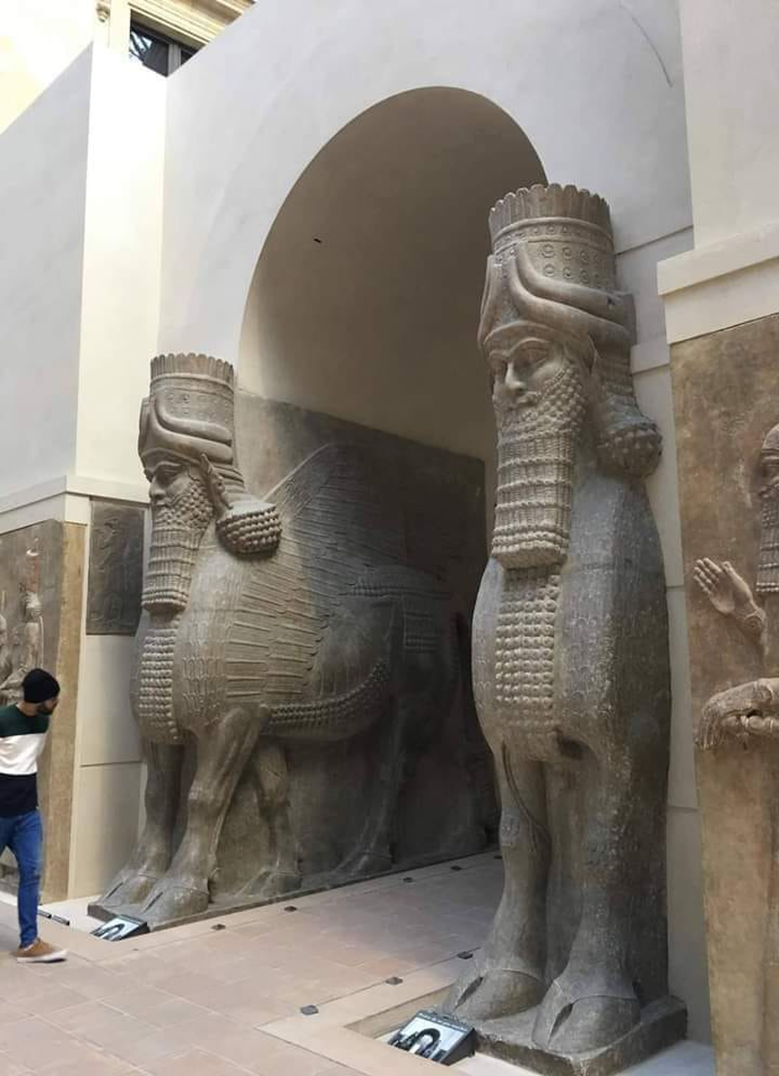Guardian creatures

In ancient Assyrian thought - the winged bull is a model - the Assyrian kings and princes decorated the entrances to their palaces and temples with composite creatures that they called “lamasu” - a mixture of human and animal powers that were combined in a coordinated form. According to the belief of the ancient people of Assyria, these composite creatures had the ability to exorcise spirits. The evil that could enter these buildings - In its form, which consists of the head of a human, the body of an animal, and the wings of a bird, it brings together great, controlling powers. The ancient Iraqi religion and mythology gave it all respect and reverence, in addition to the fact that it combines multiple characteristics. It is a creature of the class of gods. Therefore, we see that its head dress was provided with pairs of horns, and this characteristic proves its divinity. - King - Ashurnasirpal The second - 883-853 BC. The first Assyrian kings to use these guarding creatures, although some Assyrian texts indicate their existence before the time of this king. These composite creatures served two main purposes - the first - to guard the entrances to temples and palaces and expel evil spirits and prevent them from approaching those buildings - the second. - For the purpose of architectural decoration, the sculptures of these creatures covered the walls of the entrances to the halls of the kings on both sides, in harmony with the idea of continuing the marble panels with relief sculpture that adorn and preserve the walls in Assyrian buildings. The entrances to the palaces in the city of Kaleh-Nimrud, the military capital of the Assyrian state, were placed on their front sides. These creatures are seen standing in a guarded position - the ancient origins of the forms of these complex creatures have developed in Mesopotamia since ancient times, but the model appeared in the Assyrian eras and became the example that the Assyrian sculptor emulated over time, from the northern palace of King Ashurnasirpal II. There are various statues of these creatures. There is a winged bull with a human head and a winged lion with a human head. The body of a fish was added to the belly of the bull, and a section of it was added to a pair of human hands. The Assyrian sculptor also used sculptures in the form of lions to guard the entrance to the temple of the god - Ninurta - in the city of Kalah, and these lions were not Compound or of strange shapes, except that it is equipped with five legs. At the entrance to the Izida temple for the worship of the god Nabu in the city of Kalah, the entrance to this temple was decorated with a pair of composite creatures whose body was the front of a human and the body of a fish - during the reign of the other Assyrian king - Sennacherib - 704-681. BC: A winged creature appeared at the entrances to the palaces of the city of Nineveh. His body is seated in the form of a lion, with a human head appearing on top of feathers - but the astonishment of the terrifying winged bull remains the most important model - one day Professor Edward Kiera was guiding some visitors in one of the exhibition halls of the Oriental Institute at the University of Chicago - they first stopped in front of the huge statue of the Assyrian winged bull. It was a terrifying sight - they stood with astonishment on their faces as they examined the magnificence of the winged bull, because of the majesty and awe of its composition. The statue was carved from a single piece of Mosul alabaster and weighs more than twenty tons. It symbolizes the greatness of the Assyrian Empire and its control over the ancient world. It represents a composite being with a human head, which expresses wisdom, reason, and judgment. It symbolizes the head of the ruling king, because he carries a crown on his head. He has double wings that symbolize his power in the sky, and they are related to the king’s journey to the gods. As for the body, it is the body of the bull, which represents the Assyrian power on earth. Its influence moved from Mesopotamia to the Hittites, Achaemenids and Sassanians with the image of the winged horse - and his idea entered the Christian religion with the image of the winged angels who carried the Prophet - Jesus - to heaven and to Islam with the image of Al-Buraq who carried the Prophet Muhammad - may God bless him and grant him peace - to the sky on the night of the Night Journey and Mi’raj - and he is one of the winged bulls that the mission took. American excavations from the Assyrian-Iraqi region of Khorsabad and transferred it to the museum of the aforementioned institute. Glory and honor to those first Iraqis, builders of the world's first civilizations -----
Sources
Iraqi Civilization Book - Part 4 - pp. 91 - 92 - 93 - 94 - Elite Iraqi Researchers
Book Written on Clay - pp. 1 - 2 - Edward Kiera

